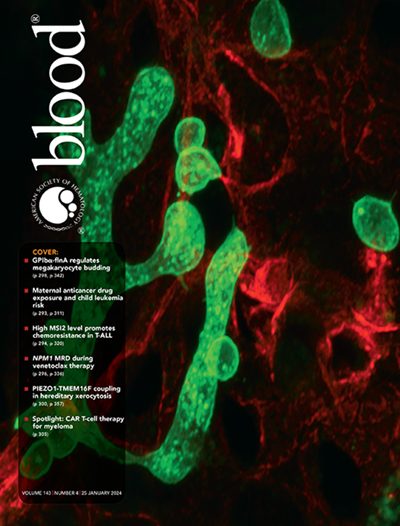resonance -2研究的最终分析:一线依鲁替尼治疗CLL/SLL长达10年的随访。
IF 23.1
1区 医学
Q1 HEMATOLOGY
引用次数: 0
摘要
经过长达10年的随访,我们报告了resonance -2 (NCT01722487/NCT01724346)的最终分析结果,这是一项一线依鲁替尼与氯苯布西治疗慢性淋巴细胞性白血病/小淋巴细胞性淋巴瘤(CLL/SLL)的3期研究。年龄≥65岁的既往未治疗的无del(17p) CLL/SLL患者随机分配接受单药伊鲁替尼(420mg /天;N = 136)或氯霉素(0.5-0.8 mg/kg≤12个周期;N = 133)直到疾病进展/不可接受的毒性。伊鲁替尼组的中位随访时间为9.6,中位PFS为8.9年(95% CI, 7.0-NE),而氯霉素组的中位PFS为1.3年(95% CI, 0.9-1.6)。在未突变的IGHV、del(11q)、突变的TP53或复杂核型患者中,伊鲁替尼组的中位PFS为8.4年(95% CI, 6.8-NE),氯霉素组的中位PFS为0.7年(95% CI, 0.4-1.2)。伊鲁替尼的中位总生存期(OS)未达到。最常见的不良事件(ae)包括腹泻(52%)、疲劳(41%)、咳嗽(39%)、恶心(32%)、关节痛(31%)、外周水肿(31%)和高血压(30%)。在整个研究期间,34/136例患者(25%)因不良事件而减少伊鲁替尼剂量;34例患者中有30例(88%)的ae得到改善。在研究结束时,27%的患者仍然接受一线伊鲁替尼治疗。这项具有里程碑意义的RESONATE-2研究是迄今为止所有靶向CLL/SLL治疗的3期研究中最长的随访,定义了中位PFS,并证明一线伊鲁替尼治疗CLL/SLL患者(包括具有高风险基因组特征的患者)的持续OS益处。伊鲁替尼的持续疗效和耐受性再次强调了有利的获益-风险概况。本文章由计算机程序翻译,如有差异,请以英文原文为准。
Final analysis of the RESONATE-2 study: up to 10 years of follow-up of first-line ibrutinib treatment for CLL/SLL.
With up to 10 years of follow-up, we report results from the final analysis of RESONATE-2 (NCT01722487/NCT01724346), a phase 3 study of first-line ibrutinib versus chlorambucil for the treatment of chronic lymphocytic leukemia/small lymphocytic lymphoma (CLL/SLL). Patients aged ≥65 years with previously untreated CLL/SLL without del(17p) were randomly assigned to receive either single-agent ibrutinib (420 mg/day; n = 136) or chlorambucil (0.5-0.8 mg/kg ≤12 cycles; n = 133) until disease progression/unacceptable toxicity. With a median follow-up of 9.6 in the ibrutinib arm, median PFS was 8.9 years (95% CI, 7.0-NE) versus 1.3 years (95% CI, 0.9-1.6) for the chlorambucil arm. Among patients with unmutated IGHV, del(11q), mutated TP53, or complex karyotype median PFS was 8.4 years (95% CI, 6.8-NE) with ibrutinib and 0.7 years (95% CI, 0.4-1.2) with chlorambucil. Median overall survival (OS) with ibrutinib was not reached. Most common adverse events (AEs) of any grade included diarrhea (52%), fatigue (41%), cough (39%), nausea (32%), arthralgia (31%), peripheral edema (31%), and hypertension (30%). During the entire study period, 34/136 patients (25%) had an ibrutinib dose reduction due to AEs; these AEs improved in 30/34 patients (88%). At study completion, 27% of patients remained on first-line ibrutinib treatment. With the longest follow-up to date from a phase 3 study of any targeted CLL/SLL therapy, this landmark RESONATE-2 study defines median PFS and demonstrates continued OS benefit of first-line ibrutinib treatment for patients with CLL/SLL, including those with high-risk genomic features. Sustained efficacy and tolerability of ibrutinib reemphasize the favorable benefit-risk profile.
求助全文
通过发布文献求助,成功后即可免费获取论文全文。
去求助
来源期刊

Blood
医学-血液学
CiteScore
23.60
自引率
3.90%
发文量
955
审稿时长
1 months
期刊介绍:
Blood, the official journal of the American Society of Hematology, published online and in print, provides an international forum for the publication of original articles describing basic laboratory, translational, and clinical investigations in hematology. Primary research articles will be published under the following scientific categories: Clinical Trials and Observations; Gene Therapy; Hematopoiesis and Stem Cells; Immunobiology and Immunotherapy scope; Myeloid Neoplasia; Lymphoid Neoplasia; Phagocytes, Granulocytes and Myelopoiesis; Platelets and Thrombopoiesis; Red Cells, Iron and Erythropoiesis; Thrombosis and Hemostasis; Transfusion Medicine; Transplantation; and Vascular Biology. Papers can be listed under more than one category as appropriate.
 求助内容:
求助内容: 应助结果提醒方式:
应助结果提醒方式:


